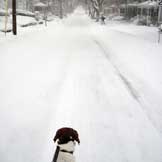 This article originally appeared on Dr. Mahaney’s The Daily Vet column on petMD.
As we progress through winter, some parts of the country have been exposed to harsher climates than others. Having grown up on the East coast, I much prefer to live in the consistently warm temperatures found in Southern California. Actually, my seemingly seasonal bouts of bronchitis are much less prevalent now that I’m minimally exposed to "real winter."
But enough about my health. Let’s discuss how freezing temperatures, accumulation of ice and snow, and man’s attempts to combat winter’s assault put our companion canines and felines at risk for a variety of health problems.
This article originally appeared on Dr. Mahaney’s The Daily Vet column on petMD.
As we progress through winter, some parts of the country have been exposed to harsher climates than others. Having grown up on the East coast, I much prefer to live in the consistently warm temperatures found in Southern California. Actually, my seemingly seasonal bouts of bronchitis are much less prevalent now that I’m minimally exposed to "real winter."
But enough about my health. Let’s discuss how freezing temperatures, accumulation of ice and snow, and man’s attempts to combat winter’s assault put our companion canines and felines at risk for a variety of health problems.
Wintry Climate Changes
Frostbite happens when the skin is exposed to extreme temperatures, which restricts blood flow to the body’s surfaces. Reduced delivery of oxygen and nutrients and removal of metabolic waste contributes to cell damage or death. Body tissues become cold to the touch and appear pale pink, white, or even blue. Unresolved frostbite can progress to gangrene, which requires ongoing and costly veterinary medical and surgical treatment. Hypothermia occurs when body temperature drops below the normal range of 100-102.5 +/- 0.5 in a healthy cat or dog. In order to preserve the vital organs (brain, heart, kidneys, liver, and lungs), blood flow to the extremities (limbs, feet, ears, etc.) is restricted. Hypothermia also contributes to frostbite. Exposure to moisture increases your pet’s likelihood of developing frostbite and hypothermia. A healthy fur pelt or moisture repelling-fabric coat can provide limited protection from nature’s assault. Geriatric, juvenile, mobility compromised, and sick pets are more prone to suffering negative health consequences of exposure to wintry weather.Man-Made Dangers
Frozen water and frigid temperatures motivate man’s attempts to promote safer walking and driving. Unfortunately, while striving to promote human safety we inadvertently create pet health hazards. Rock salt and other deicing agents applied to streets and sidewalks can irritate paws or cause digestive tract upset (decreased appetite, diarrhea, vomit, etc.) if consumed. Antifreeze (ethylene glycol) leaking from car engines creates a toxic pool of palatable liquid that quickly causes kidney failure or even death if ingested.Keep Your Pets Safe from Winter’s Climate Changes and Man-Made Dangers
Schedule a wellness exam so your veterinarian can evaluate your pet’s body for disease conditions that can be exacerbated by inclement weather (arthritis, heart and lung disease, hyper-/hypothyroidism, kidney and liver failure, etc.). Keep cats indoors instead of roaming free. Cold, ice, snow, and increased hours of darkness makes finding the way home more challenging. Walk your dog on a leash and under close observation. Choose sidewalks (free from deicers, of course), lawns, or paths instead of roads where visibility may be limited for oncoming drivers. Avoid areas where antifreeze and rock salt may collect, such as sidewalks and parking spots. Use sand or pet-safe deicers (Safe Paw, Morton’s Safe-T-Pet, etc.) instead of salt. Have your car professionally serviced away from your home to avoid spills of toxic substances like antifreeze. Fill your vehicle with pet-safe antifreeze (propylene glycol, just like the ingredient found in many moist, "faux meat" pet treats … YUCK). Use a warm-water moistened soft cloth to wipe off your pet’s paws before coming indoors (light colored fabric lets you see the substances coming off your pet’s paws). Properly identify your canine and feline companions with a collar, tag, and microchip. Choose accessories that have reflective properties to reflect the glare of a car’s lights. * Have you or your pet suffered any health problems associated with wintry climate or man-made hazards? Please share your story in the comments section. Dr. Patrick Mahaney
Thank you for reading this article. Your questions and comments are completely welcome (I’ll respond).
Please feel free to communicate with me through Twitter (@PatrickMahaney) and follow my adventures in veterinary medicine by liking Patrick Mahaney: Veterinarian Acupuncture Pain Management for Your Pets on Facebook.
Copyright of this article (2013) is owned by Dr Patrick Mahaney, Veterinarian and Certified Veterinary Acupuncturist. Republishing any portion of this article must first be authorized by Dr Patrick Mahaney. Requests for republishing must be approved by Dr Patrick Mahaney and received in written format.
Dr. Patrick Mahaney
Thank you for reading this article. Your questions and comments are completely welcome (I’ll respond).
Please feel free to communicate with me through Twitter (@PatrickMahaney) and follow my adventures in veterinary medicine by liking Patrick Mahaney: Veterinarian Acupuncture Pain Management for Your Pets on Facebook.
Copyright of this article (2013) is owned by Dr Patrick Mahaney, Veterinarian and Certified Veterinary Acupuncturist. Republishing any portion of this article must first be authorized by Dr Patrick Mahaney. Requests for republishing must be approved by Dr Patrick Mahaney and received in written format.